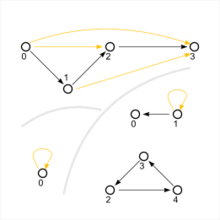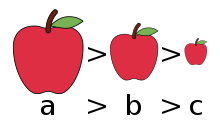Transitive relation
![]()
This article or subsequent section is not sufficiently supported by evidence (e.g. itemised). Information without sufficient evidence may be removed in the near future. Please help Wikipedia by researching the information and adding good supporting evidence.
A transitive relation in mathematics is a two-digit relation 













A non-transitive relation is called intransitive (not to be confused with negative transitivity). Transitivity is one of the prerequisites for an equivalence relation or an order relation.

Two transitive and one non-transitive relation (bottom right), shown as directed graphs
Formal definition
If 



Representation as a directed graph
Any relation 






The transitivity of 


Properties
- The transitivity of a relation
also allows inferences across several steps (as is easily shown by complete induction):
- With the help of the concatenation
of relations, transitivity can also be characterised by the following condition:
- If the relation
transitive, then this is also true for the converse relation
. Examples: the relation that is converse to ≤ {\displaystyle
≥
which is converse
to is > {\displaystyle
- If the relations
and are
transitive, then this is also true for their intersection
. This statement can be generalised from two relations to the average
any family of transitive relations.
- For any relation
is a smallest transitive relation
which
contains , the so-called transitive hull of
.
Example: Letbe the antecedent relation on the set of natural numbers, so let
. The relation
itself is not transitive. As a transitive envelope of the smaller relation
results.
Examples
Order of the real numbers
The lessor relation 

Likewise, the relations 


Equality of the real numbers
The ordinary equality 



The inequality relation 



Divisibility of the integers
The divisibility relation 



For example, the divisor strangeness is not transitive. Thus 






Subset
The subset relation 




For example, the disjointness of sets is not transitive. Thus the sets 





Parallel straight lines
In geometry, the parallelism of lines is transitive: if both the lines 





Implication in logic
In logic, transitivity applies with regard to implication, although in predicate logic this is also known as modus barbara:
From 


The implication defines a quasi-order on the formulae of the logic under consideration.

From a > b and b > c follows a > c
See also
- Transitive shell
- Negative transitivity
Search within the encyclopedia


